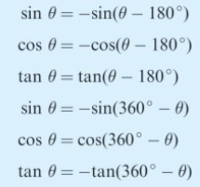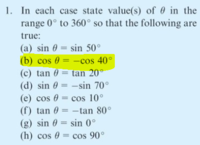bushra1175
Junior Member
- Joined
- Jun 14, 2020
- Messages
- 59
I am using the identity cos θ = -cos(θ -180∘) as this is part of a list of identities in the textbook:

Also, the confusing thing is, this identity is also included so I'm not even sure I'm using the correct one:

Anyway, the question is below:

I substituted θ for 40∘ in cos θ = -cos(θ -180∘) which brings me to cos θ = -cos(40∘ -180∘), which is -cos(-140∘). This equals 0.7660. However, -cos 40∘ in the original expression equals -0.7660 so the two values don't equate each other. I feel like I'm using the identity wrong so I would appreciate the help.

Also, the confusing thing is, this identity is also included so I'm not even sure I'm using the correct one:
Anyway, the question is below:

I substituted θ for 40∘ in cos θ = -cos(θ -180∘) which brings me to cos θ = -cos(40∘ -180∘), which is -cos(-140∘). This equals 0.7660. However, -cos 40∘ in the original expression equals -0.7660 so the two values don't equate each other. I feel like I'm using the identity wrong so I would appreciate the help.
Last edited:
